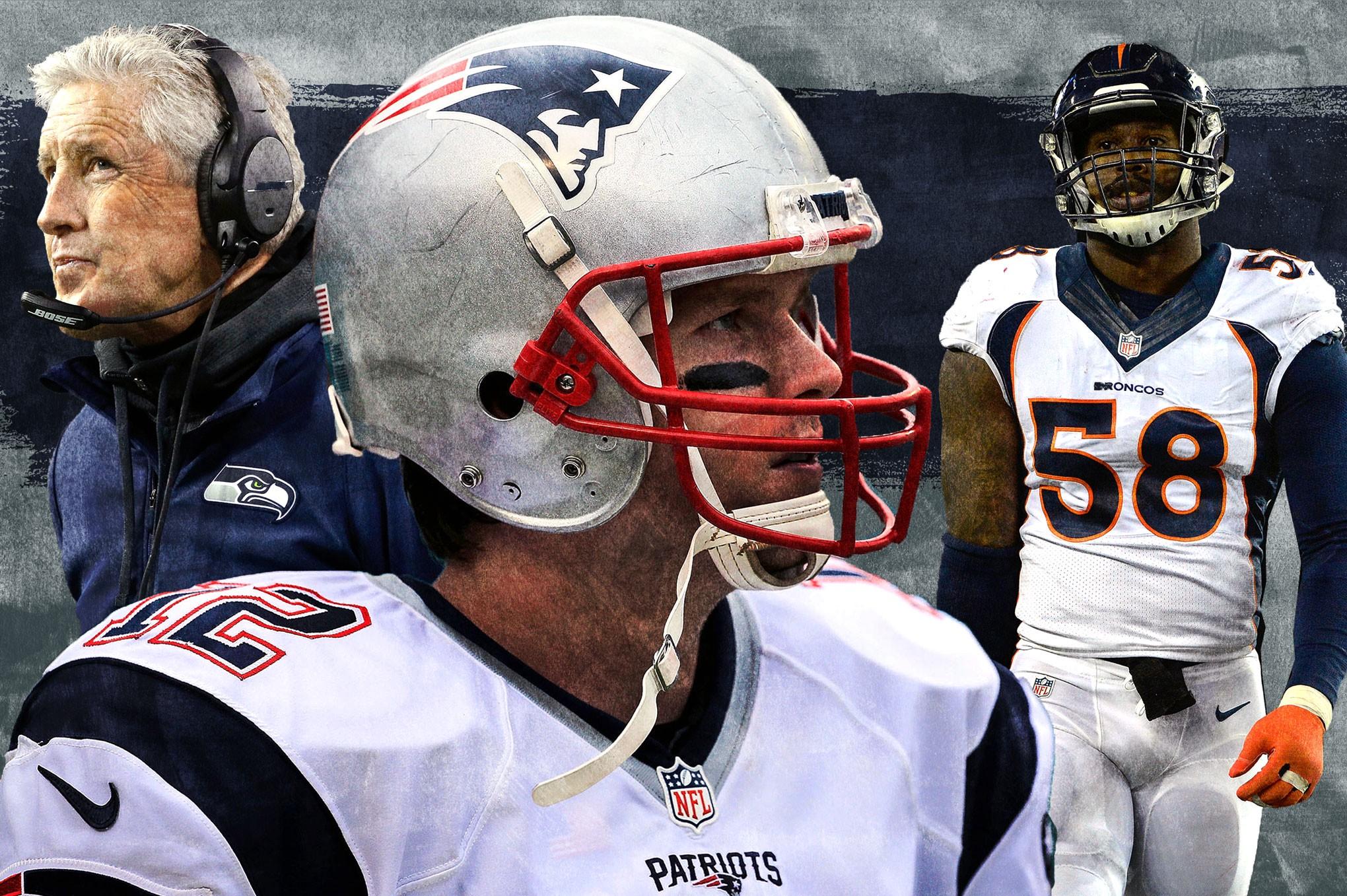
The NFL values parity above just about everything. The draft order is designed to distribute elite college talent to bad teams. Meanwhile, the league’s salary cap makes it harder for teams to keep all of the players that eventually make them good. These two forces, when combined, push the best teams down in the standings and lift the worst teams up. As Seahawks GM John Schneider said last year, “This league, truly, because of the parity, drives you to 8–8.”
From one season to another, we see a huge amount of turnover among the playoff teams, and at the other end of the spectrum, a new franchise almost always ends up at the top spot of the draft each season. (The last team to pick first two years in a row was the Browns in 1999 and 2000.) But even against the strong currents that push and pull teams in these opposing directions, a select few clubs have managed to dig their heels in and do the thing that’s become so hard to do in the modern NFL: win consistently.
Having Tom Brady or Aaron Rodgers on your team certainly doesn’t hurt, but year-after-year success comes down to more than just a top-tier quarterback. We’ve seen down years from Matt Ryan’s Falcons, Drew Brees’s Saints, Philip Rivers’s Chargers, Eli Manning’s Giants, and even Ben Roethlisberger’s Steelers. To keep winning in the NFL, it takes balance, identity, continuity, and a little bit of luck.
Here are the league’s most consistent teams from the past four seasons.
New England Patriots
Shocker, I know. Let us count the ways of New England’s consistency: For one, the Patriots have finished with the exact same record (12–4) every year going back to 2012. They’ve also absolutely dominated the AFC East, winning the divisional title every year since 2009. And they’ve been true contenders for the conference title four years running, winning one Super Bowl while appearing in four AFC championship games.
New England isn’t only consistent in the win-loss column, either. Its overall DVOA rankings the past four years — sixth in 2015, fourth in 2014, fifth in 2013, and third in 2012 — have regularly hovered near the top, and its offense/defense splits are similarly consistent. The Patriots finished fifth in offensive DVOA in 2015, sixth in 2014, fourth in 2013, and first in 2012, compared to 12th, 12th, 20th, and 15th on defense during that same period.
In other words, the Patriots have been winning the same way every year: lots and lots of offense — with Tom Brady at the vanguard — and a solid-if-unspectacular defense backing them up.
New England’s offensive identity has remained centered on tempo. The Patriots ran a play every 26.73 seconds in 2015 — ninth fastest in the NFL — and going back four years, New England has ranked second, third, and first in the league in offensive pace. The Patriots believe in running as many plays as possible and never taking their foot off the opposing defense’s throat. It’s worked, as no team has scored as many points as the Patriots over the past four years.
The high-speed offense is possible because of Brady’s mastery of the pre-snap phase, where he moves his receivers and tight ends around to exploit mismatches and weaknesses. But he’s surgical after the snap, too, and his time-to-throw has dropped every year since 2012. So not only are the Patriots getting the snap off quickly, they’re getting the ball out of the quarterback’s hands faster and faster. Despite this, Brady’s average depth of target remains above 8 yards. Brady’s ability to run the offense at that pace, get the ball out of his hands quickly, and still throw it downfield is unmatched. He’s truly ridiculous.
While the defense has lagged behind the offense in efficiency, New England has 116 takeaways in the past four years, fifth in the NFL behind only the Cardinals, Panthers, Giants, and Seahawks. This complements the Patriots’ high-powered offense well: Creating turnovers puts the ball back into Brady’s hands.
Denver Broncos
Since 2012, the Broncos have won four straight AFC West titles, two AFC championships, and a Super Bowl, finishing with records of 12–4, 12–4, 13–3, and 13–3 over that stretch. Unlike New England’s carbon copies, Denver’s championship-caliber teams have looked different every season.
In 2012, Peyton Manning’s first season with the team, Denver’s success was born of balance on both sides of the ball: the Broncos finished second in overall DVOA, second on offense, and fifth on defense. The next year, Manning hit his stride, tossing 55 touchdown passes at the helm of the most prolific offense ever assembled. The 2013 defense finished middle of the pack (15th in DVOA), and when Denver’s seemingly unstoppable offense was dismantled by the elite Seattle Seahawks defense in Super Bowl XLVIII, Broncos executive vice president of football operations/GM John Elway took note — then switched gears.
In free agency, he added a trio of big-time defenders — safety T.J. Ward, pass rusher DeMarcus Ware, and cornerback Aqib Talib — and while Manning’s numbers waned slightly in 2014, the defense began its ascent. After bowing out against the Colts in the divisional round, Manning hit the performance cliff in 2015 (to put it as lightly as possible), and Denver’s offense finished 25th in DVOA. But Elway surely knew this was looming, as we saw Denver’s identity completely flip to the defensive side of the ball.
Led by Von Miller, the Broncos had the NFL’s most dominant defense all year long (first in DVOA), led the league in sacks (52) and passing yards allowed (199.6 yards per game), and capped it with an authoritative Super Bowl victory despite Manning and the offense.
It’s rare to see a team flip its identity from a high-flying offense to a havoc-wreaking defense so quickly, but it’s basically unheard of for that team to make it to the Super Bowl in both forms, just two years apart.
Seattle Seahawks
While Seattle owns the NFC’s best win percentage since 2012 (.719), its record has actually fluctuated a little bit: The Seahawks finished 10–6 in 2015, 12–4 in 2014, 13–3 in 2013, and 11–5 in 2012. They’ve won the NFC West only two out of those four years (finishing second to the Cardinals in 2015 and second to the 49ers in 2012), but, efficiency-wise, they’ve been the most consistent team in the NFL.
The Seahawks have finished first overall in DVOA in each of the past four seasons — they’re the first team to do that — and their defense has been at the heart of their success. Pete Carroll’s group has also allowed the fewest points to opposing offenses for four straight seasons, and that’s never happened in the modern era, either. Incredibly, they’ve done all of this with three different defensive coordinators calling the plays, a testament to Carroll’s Cover-3-heavy scheme and his players’ mastery of their individual roles.
It’s not just a dominant defense that’s allowed them to win a Super Bowl and two NFC championships during their recent run, though.
Seattle’s offense finished first overall per DVOA last year and prior to that, the Seahawks ranked fifth, seventh, and fourth, respectively. The Seahawks rush offense has been consistently among the league’s best, as they’ve adapted to the read option, scramble-friendly style that so perfectly suits Russell Wilson. They finished third in rushing yards in 2015, first in 2014, fourth in 2013, and third in 2012. As Carroll says, the offense’s core tenet is “We’re going to beat the hell out of you if we can.”
Marshawn Lynch is retired and Russell Wilson is improving as a pocket passer, but it’d be surprising if the Seahawks deviated too far from the equation that’s made them so consistent the past four years. As teams around the league throw the ball more and more, Seattle’s dedication to offensive balance has separated it from the pack.
The Second Tier: Cincinnati Bengals, Green Bay Packers, Carolina Panthers, and Indianapolis Colts
These four teams aren’t in the same class as New England, Denver, and Seattle, but they’ve all been consistently decent-to-good over the past four years.
The Bengals have finished each of the past four seasons with at least 10 wins and have won the AFC North twice. The Packers have been consistently strong as well, finishing top 10 in overall DVOA in three out of four years, with their one down year in 2013 (20th in DVOA, 8–7–1 overall) still producing an NFC North title. The Green Bay offense, led by Aaron Rodgers, has finished 11th, first, ninth, and third per DVOA, respectively, over the past four years. So even with Rodgers’s down year in 2015, which saw full-season career lows in yards per pass attempt (6.7), completion percentage (60.7), and quarterback rating (92.7), they’ve remained a force.
Elsewhere, the Panthers won only one game over a 10-week stretch early in 2014, but they did rally late in the year to win the NFC South at 7–8–1. Their 7–9 record in 2012 — which caused them to miss the playoffs — is a blemish as well. But with a three-year run of division titles and an extremely impressive 18-game regular-season win streak stretching from 2014 to 2015 (something only four teams have ever matched), the Panthers have proven that their brand of football — suffocating defense combined with a smashmouth run game and vertical passing offense with Cam Newton — is consistent and reliable.
Then there’s the Colts. Record-wise, Indianapolis has been relatively consistent, finishing 11–5 every year from 2012 to 2014 before dipping to 8–8 last season after losing Andrew Luck to injury from Week 10 on. Still, even with a 41–23 record over their past four seasons, their overall DVOA has been closer to middling than elite (23rd in 2015, 13th in 2014, 13th in 2013, and 25th in 2012).
Even looking at their offense/defense DVOA splits during this time, the highest the Colts have finished on either side of the ball is 13th. Part of the explanation for their success despite a lack of efficiency is that they’re in the worst division in football. They have mopped up against the Texans, Titans, and Jags for a 20–4 record since 2012, but they’ve gone only 21–19 against all other opponents in that time. Still, wins are wins, and the Colts have consistently earned victories, particularly when Luck is under center.
The Colts might not be consistently good every year, but maybe they’ve found the cheat code to consistently winning games: Be in the AFC South.

